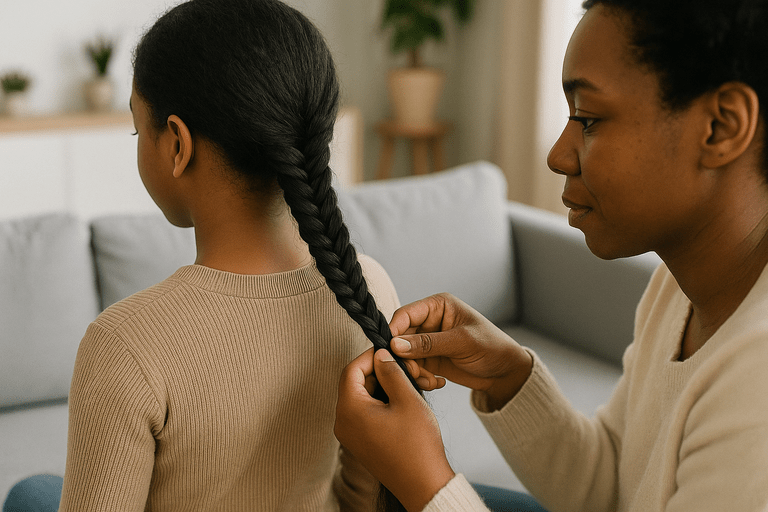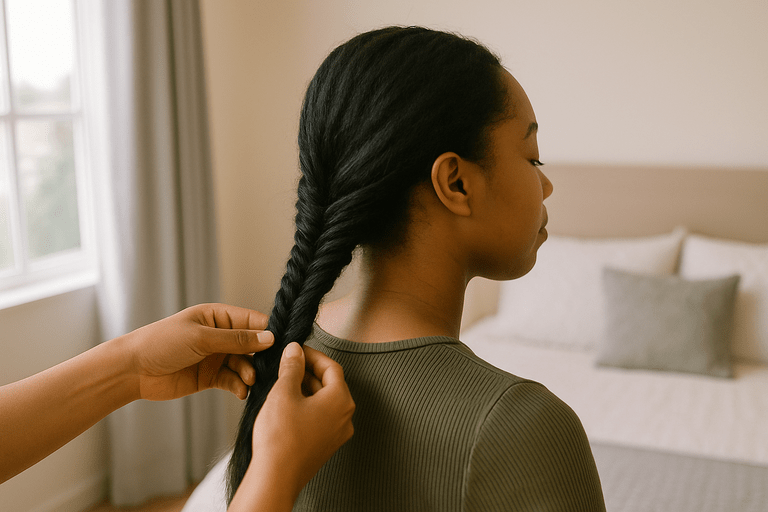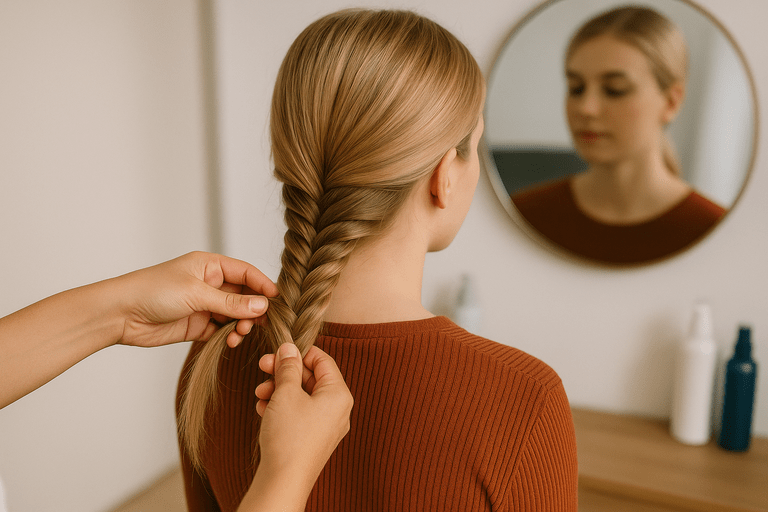In today’s world of ever-changing beauty trends, few hairstyles remain as timeless and versatile as the fishtail braid. Knowing how to do a fishtail braid allows you to create a polished look suitable for everyday wear, formal events, or even last-minute style fixes. It’s not just about fashion—it’s about self-expression.
In addition, mastering this braid can save time and money. Instead of relying on stylists, you can confidently handle your own hair for any event. Therefore, this skill becomes a tool of both style and independence. With the right technique, you’ll have a reliable go-to that looks complex but is surprisingly easy.
How to Do a Fishtail Braid: Prep and Tools You Need
To begin, gather the essential tools: a detangling brush, a fine-tooth comb, two hair elastics, and a bit of texturizing spray. If your hair is freshly washed, apply a small amount of dry shampoo to increase grip and texture.
When learning how to do a fishtail braid, preparation makes all the difference. Start by brushing out any tangles. For more volume, flip your head upside down and brush from the roots. Then divide your hair to one side if you prefer asymmetry, or leave it centered for a traditional finish.
In addition, use a light serum or leave-in conditioner for shine and smoothness. A small investment in hair prep leads to better structure, reduced frizz, and easier braiding overall.

How to Do a Fishtail Braid: The Step-by-Step Breakdown
The core technique is simple. First, split your hair into two equal sections. Then, from the outside of the right section, take a small piece and cross it over to the left section. Next, take a small strand from the outside of the left and cross it over to the right.
How to Do a French Braid Like a Pro
Repeat this alternating motion while keeping consistent tension. As you progress, your braid will begin to form that signature woven pattern. Knowing how to do a fishtail braid also means being mindful of strand size: smaller pieces create tighter detail, while larger ones make it more casual.
Once you reach the bottom, tie it off with a hair elastic. Tug lightly at the sides to “pancake” the braid for added volume. This technique works especially well on fine or layered hair.
Styling Ideas Once You’ve Learned the Basics
Mastering how to do a fishtail braid opens the door to a variety of styles. For a casual day, wear a loose side fishtail with a messy top bun. For something more formal, wrap your braid into a low chignon. This transforms the style into an elegant updo.
In addition, you can accessorize your braid with ribbons, gold cuffs, or decorative pins. These small touches personalize your look and make it suitable for everything from coffee dates to red carpet events. Even a simple braid can look glamorous with the right add-ons.
You might also experiment with partial braids, like a fishtail crown braid or half-up half-down look. Each option builds on the same foundational technique.

Hair Types and Textures: Adjusting Technique Accordingly
The good news is that fishtail braids work for nearly all hair types. However, understanding how to adjust technique based on hair texture will help you master how to do a fishtail braid like a professional. For straight or fine hair, adding grip with mousse or texture spray prevents slippage.
For curly or wavy textures, braid when your hair is damp and well-conditioned. This helps reduce frizz and makes strands easier to manage. Coarser textures may benefit from a bit of edge control cream, especially at the roots, to maintain smoothness.
How to Put My Hair in a Bun Step by Step
Moreover, shorter hair can still be fishtail-braided—simply use the top layers for a crown or fringe-style braid and secure with pins.
Common Mistakes and How to Avoid Them
Everyone starts somewhere, and the most frequent issue when learning how to do a fishtail braid is rushing the process. When you braid too quickly, sections become uneven, and the look turns sloppy. Instead, go slowly at first to build muscle memory.
Another common mistake is grabbing sections that are too large. This flattens the pattern and makes the braid look more like a twist. Keep each section thin and consistent. Also, don’t forget to secure the ends tightly—loose elastics will cause the braid to unravel faster.
In addition, resist the urge to over-pancake. While it adds volume, too much pulling can distort the structure entirely.
Wearing Your Fishtail Braid for Different Occasions
One of the greatest advantages of learning how to do a fishtail braid is how adaptable the style becomes. Going to the gym? A tight braid keeps hair off your face. Heading to a party? Add a side part and some waves at the crown for elegance.
For weddings and other formal events, opt for polished finishes. Consider wrapping a thin section of hair around your elastic for a seamless, refined detail. In colder seasons, tuck the braid under a scarf or beanie—its flat profile makes it perfect for layering.
How to Wear a Beret with Short Hair Stylishly
Each scenario offers a chance to reinvent the braid without changing its core shape.

Advanced Techniques and Creative Variations
Once you’ve nailed the basic pattern, step up your game with more advanced techniques. Try double fishtail braids (pigtail style), or combine a French braid into a fishtail continuation. You can even braid your fishtail backward (starting from the bottom up) for a twist.
Understanding how to do a fishtail braid also means exploring hybrids. Mix it with rope braids or tuck it into a twisted bun. Each variation adds complexity and visual interest. These advanced versions are especially popular in editorial fashion, stage performances, and even bridal hair.
To add extra flair, weave in silk ribbon, thread, or even small chains. These techniques can make a standard braid look custom-designed.
Maintenance Tips to Keep Your Braid Looking Fresh
To keep your fishtail braid intact all day, spray a flexible hold hairspray lightly after completion. If strands start to loosen, smooth them down with a small amount of pomade or wax on your fingertips.
Knowing how to do a fishtail braid includes knowing how to touch it up. Always carry a mini elastic and a few bobby pins in your bag. For longer wear (like overnight), sleep with a silk pillowcase to avoid frizz and friction. In the morning, mist the braid with water to revive its shape.
Consistency in care makes the difference between a braid that lasts two hours and one that lasts all day.
Quick Recap
Here’s a summary of everything we’ve covered about how to do a fishtail braid:
- Start with clean, detangled, textured hair for best control.
- Use two equal sections—not three—unlike a traditional braid.
- Alternate small outer strands from each side to create the braid.
- Secure the end with a strong elastic and tug for volume.
- Match your braid style to the occasion—from gym-ready to bridal.
- Adjust technique based on your hair type and texture.
- Avoid common mistakes like large sections or uneven tension.
- Get creative with advanced variations and accessories.
- Maintain your braid with product, pins, and protective fabrics.
- Practice regularly to develop skill and speed.
Final Thoughts: Confidence Through Consistency
Mastering how to do a fishtail braid gives you more than a hairstyle—it gives you freedom. You can switch from messy-chic to red-carpet-ready in under ten minutes, all without heat or damage. The braid empowers your personal style and builds confidence.
More importantly, as you improve, braiding becomes therapeutic. It’s a moment of mindfulness, self-care, and creativity all wrapped in one technique. So take a mirror, carve out five minutes, and start braiding. You’re only a few strands away from a whole new look.

